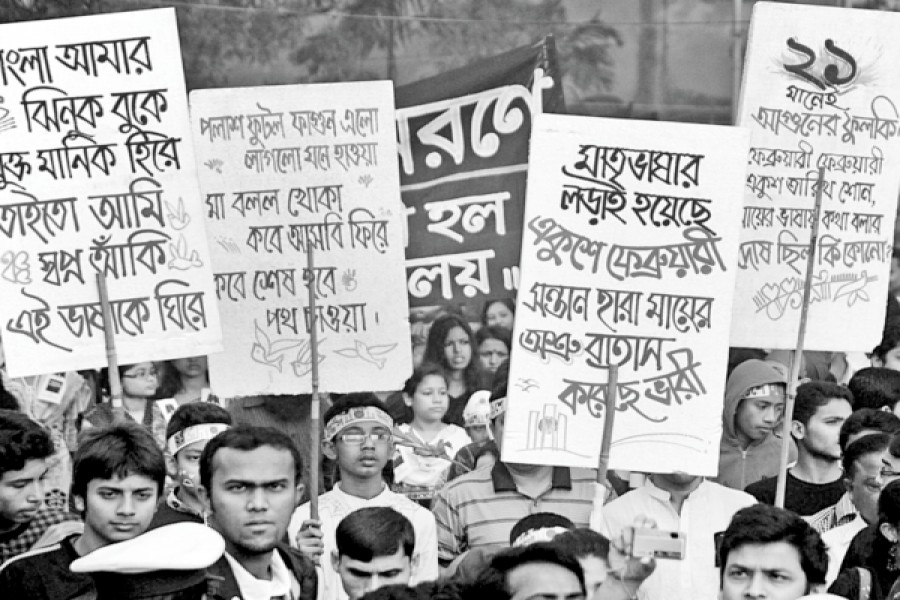
Published :
Updated :

Nothing captures the Bengali spirit of the "historical" variety like the Ekushey going by the dominant narrative of the shushil class/community. It's when "we discovered who we were and progressed through history" as the narrative goes. It is supposed to have given us a sense of identity which we lacked till the police fired on the rebellious students in Dhaka University (DU) and gave us a national iconic imagination.
Of course it came as part of a process that began from 1947 onwards triggered by the students of DU as per his narrative. This narrative has stayed on as all national "imagining's have made it the core of the socio-political struggles based on cultural identity as the primary issue. Thus what defined the struggle at the core was the proto-race based "ethnicity" framework rather than economic struggle. This allowed the rise of the intellectual culture as the manifest reason for seeking a new state which came with discrimination and other ailments.
Thus the Ekushey spirit was upheld as the supreme mobilizer of the people which also put the shushils at the top of the leadership chain. This may roughly be defined as the format of the Bengali nationalism which has acted as the generator of the Bangladesh state. It's the mantra by which the old middle class swears. It's fine except that another cultural variation is knocking at the door. And it's rather loud.
Politics of the colonial era is often described as "identity" politics both by the nationalists and the Marxists alike signifying that their intellectual sources were the same and drawn from the earlier Western traditions. By that they meant cultural identities such as Muslims, Bengalis and so on were what mattered. It was somewhat superficial reading which ignored the multiplicity of factors that has dominated history making in the region and this state.
One can understand the lack of depth of class analysis on the part of the nationalists who saw class as a contest of their community-based framework. However, why Marxists never saw the class content in the "identity" politics shows that both opposing ideas were basically repeating Euro centricity to identify local context. That error was historical but inevitable given that both were birthed by colonialism as far as "India" is concerned.
Mono-causal vs multi-causal history is the basic difference that has significantly marginalized the older middle class which we are tagging as the "Ekushey" class. We are either Bengali or Muslims not both, according to their equation in most cases. And it has been painted as exclusive. The narrative has to be either or and has resulted in the production of the ideology as to what is acceptable and what is not.
Since Pakistan was perceived as a product of religious politics, Bengali politics was seen as contrary to that. Hence the need to invent the counter to Pakistan was more important than signifying the historical.
In 1972, the constitution was the ultimate production of the shushil state ideology which also included secularism and that resulted in the production of alienation as well. It was a by-product of people out of touch with Bangladesh. They didn't realize that the reach of the state was severely limited and such state pillars, particularly secularism, would achieve little other than creating hostility with the peasant majority.
Today, the shushils are stuck with a state which is small and inefficient, a constitution that has no operational value and a social cluster that is not significant in terms of influence anymore.
It was assumed by the old middle that there would be no challenge to their status although they were a dependent entity. They staked everything on the state, the one that was birthed by the Ekushey imagination but it neither grew nor became influential even though given a chance it was coercive and corrupt. This was because the state was a product of multiple causes, mostly economic. It was an unstable umbrella and the Ekushe shushils took shelter not realizing the weak state was barely able to do that.
Of the two economic giants that straddle both state and society, one was the RMG sector and the other is external migration. Both were largely self-generated, produced by the entrepreneurial aspirational skills of the rich class and the poor. The state played no role in their germination or growth but now that they are mature they state wants to be a referee.
The RMG workers class may not be well off but not poor and are able to create a large workforce of female workers whose coping mechanisms are strong and have therefore overcome conventional older political middle-class leadership. Their dependency on the shushil leftists have declined.
However, the class that has made the difference is the rise of the new middle class which is made up of migrant workers, the largest segment of people -at least over 150 million including the family members. They don't need the Bangladesh state for their economic survival and now constitute the new largely rural based middle class. They are in the classic sense "doubly free" but they are not the proletariat but a middle class, historically perhaps one of the first in the region.
A major by-product is the rise of the new middle class is the religious/clergy who are now using their network to contest the older middle. Thus a conflict is on. If the Ekushey is the symbolic brand of the older version, the new version looks to the crescent and the latter is strong. History will say how the contest will turn out to be but social stability and ideas under shushil control is over it seems.
afsan.c@gmail.com


 For all latest news, follow The Financial Express Google News channel.
For all latest news, follow The Financial Express Google News channel.